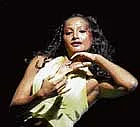

The first one called Chaaya dealt with the topic of child sexual abuse while the second piece Uruvam focused on the issue of transgender sexuality.
Hemabharathy is a senior repertory member of Attakkalari Centre for Movement Arts who has trained in Kuchupudi from the age of 12 under dancer Vyjayanthi Kashi.
Her repertoire also includes training in Bharatanatyam, Kathak, Kalarippayattu, Yoga, ballet and Pilates.
Chaaya was inspired by Bitter Chocolate, a non-fiction work on child sexual abuse written by Mumbai journalist Pinky Virani.
Going on to research the trauma and behavioural patterns of the adult survivors of child sexual abuse, Hemabharathy draws on these experiences to create a powerful 20-minute solo piece.
Gestures and expressions of disturbed behaviour patterns like thumb-sucking and angry splayed limbs recreate the body language of these tragic survivors.
Against a backdrop of an electro-acoustic musical score, Chaaya vividly recreates the trauma of a woman struggling to erase the guilt and shame of past sexual abuse.
With a blend of floor work and intense abdominal and pelvic movements, the dance style of Chaaya was very grounded and visibly different from the lofty and sylph-like techniques of classical ballet.
Her second piece Uruvam (which means form), was a contemporary dance inspired by the mythological character of Ambe in the Mahabharata. Another socially-inspired subject, Uruvam deals with the blurring lines between gender and sexuality.
Hemabharathy weaves into the choreography a mix of mythological stories, personal experiences and inputs from psychologists and experts.
“I want to address the issues faced by the transgender community through the platform of dance,” she explains.
Uruvam, was developed and produced under the auspices of the Robert Bosch Art Grant.
Uruvam was an interesting concept involving the use of unique sound design and lighting. Strong elements of her grounding in Indian classical styles were evident through
fluid movements and gestures. The piece was designed with the objective of making you feel and think of the issue she was projecting — touching
and relevant in today’s context.
DHNS
